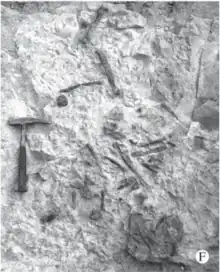Fortunictis
Fortunictis is a fossil genus of metailurin machairodontine (saber-toothed) felid containing only one species, Fortunictis acerensis. Both the genus and species were described by paleontologist Joan Pons-Moyà in 1987 based on material from Casa del Acero in Spain, which is dated back to the Upper Miocene (approximately 8.7 to 5.332 million years ago).[1][2]
| Fortunictis Temporal range: | |
|---|---|
 | |
| Fortunictis sp. skeletal material from Venta del Moro, Valencia. | |
| Scientific classification | |
| Domain: | Eukaryota |
| Kingdom: | Animalia |
| Phylum: | Chordata |
| Class: | Mammalia |
| Order: | Carnivora |
| Suborder: | Feliformia |
| Family: | Felidae |
| Subfamily: | †Machairodontinae |
| Tribe: | †Metailurini |
| Genus: | †Fortunictis Pons-Moyà, 1987 |
| Type species | |
| Fortunictis acerensis Pons-Moyà, 1987 | |
Discovery and naming
Spanish palaeontologist Joan Pons-Moyà described the genus and species in 1987 based on fossils from Casa del Acero in Spain.[1]
The generic name Fortunictis is a combination of fortuna and ictis meaning "wild cat". The specific epithet acerensis meaning "from Casa del Acera", the type locality.[1]
Further material assigned to Fortunictis was discovered at Venta del Moro in 2004.[3]
Description
Pons-Moyà described the species' diagnostic characteristics as: curved, highly laterally compressed upper canine teeth; elongated crown and no mesial cusp on the third premolar; high, transversely compressed cusps on the fourth premolar and lower; and a highly compressed first molar with a long talonid with a hypoconid cusp, but lacking the metaconid cusp.[1]
A later study further noted that F. acerensis was a highly derived metailurin with a relatively slender mandible. It further described the upper canine teeth as more flattened, the upper and lower third premolars as very elongated, and both the third and fourth premolars as well as the first molar all narrower than the related Metailurus major.[4]
Classification
Fortunictis was assigned to the tribe Metailurini in the subfamily Machairodontinae in its original description.[1]
A cladogram of the Metailurini from a 2018 phylogenetic analysis:[5]
| Metailurini |
| ||||||||||||||||||||||||||||||||||||
References
- Pons-Moyà, Joan (1987). "Fortunictis nov. gen. acerensis nov. sp. nuevo Metailurini (Mammalia, Carnivora) del Mioceno superior de la Península Ibérica" [Fortunictis nov. gen. acerensis nov. sp. new Metailurini (Mammalia, Carnivora) from the Upper Miocene of the Iberian Peninsula.]. Paleontologia i evolució (in Spanish) (21): 63–68. S2CID 133680588.
- "Fortunictis". Fossilworks. Retrieved 29 August 2023.
- Montoya Bello, Plinio; Morales, J.; Robles Cuenca, Fernando; Abella Pérez, Juan; Benavent, J. V.; Marín Monfort, María Dolores; Ruiz Sánchez, Francisco Javier (2006). "Las nuevas excavaciones (1995-2006) en el yacimiento del Mioceno final de Venta del Moro, Valencia" [New excavations (1995-2006) in the Late Miocene site of Venta del Moro, Valencia]. Estudios Geológicos (in Spanish). 62 (1): 313–326. doi:10.3989/egeol.0662126. hdl:10550/2278.
- Salesa, Manuel J.; Pesquero, María Dolores; Siliceo, Gema; Antón, Mauricio; Alcalá, Luis; Morales, Jorge (2012). "A Rich Community of Felidae (Mammalia, Carnivora) from the Late Miocene (Turolian, Mn 13) Site of las Casiones (Villalba Baja, Teruel, Spain)" (PDF). Journal of Vertebrate Paleontology. 32 (3): 665–666. Bibcode:2012JVPal..32..658S. doi:10.1080/02724634.2012.649816. JSTOR 41515286. S2CID 129246524.
- Piras, Paolo; Silvestro, Daniele; Carotenuto, Francesco; Castiglione, Silvia; Kotsakis, Anastassios; Maiorino, Leonardo; Melchionna, Marina; Mondanaro, Alessandro; Sansalone, Gabriele; Serio, Carmela; Vero, Veronica Anna; Raia, Pasquale (2018). "Evolution of the sabertooth mandible: A deadly ecomorphological specialization". Palaeogeography, Palaeoclimatology, Palaeoecology. 496: 166–174. Bibcode:2018PPP...496..166P. doi:10.1016/j.palaeo.2018.01.034.
